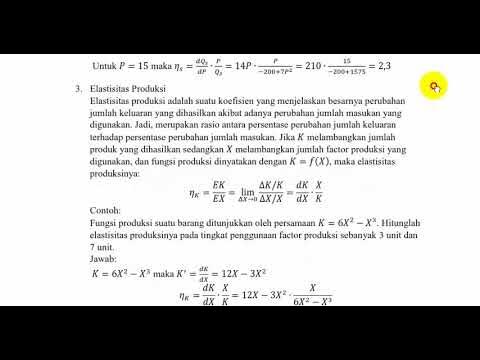ELASTISITAS PERMINTAAN DAN PENAWARAN
Summary
TLDRThis video lesson explains the concepts of demand and supply elasticity in economics. It covers how price changes influence the quantity demanded or supplied, and the factors that affect elasticity, including the availability of substitutes, income levels, and production capacity. The lesson introduces the elasticity coefficient, detailing different types of demand and supply elasticity, from perfectly inelastic to elastic. It also emphasizes how time horizons and the nature of goods (necessities vs. luxuries) affect elasticity. This comprehensive guide offers a clear understanding of elasticity, making it essential for anyone studying economics.
Takeaways
- 😀 Elasticity of demand refers to how much the quantity demanded of a good changes in response to a price change.
- 😀 Demand is considered elastic when a small price change leads to a large change in quantity demanded.
- 😀 Demand is inelastic when a price change has little or no effect on the quantity demanded.
- 😀 The availability of substitutes plays a crucial role in determining the elasticity of demand: more substitutes lead to higher elasticity.
- 😀 A higher income reduces the elasticity of demand, making consumers less sensitive to price changes.
- 😀 Primary goods (basic necessities) tend to have inelastic demand, while secondary or luxury goods tend to have more elastic demand.
- 😀 Over time, the elasticity of demand generally decreases, meaning demand becomes less responsive to price changes as time passes.
- 😀 The coefficient of elasticity ranges from 0 to infinity, with 0 indicating perfectly inelastic demand and infinity indicating perfectly elastic demand.
- 😀 Elasticity of supply refers to how much the quantity supplied changes when the price of a good changes.
- 😀 Similar to demand, factors like production capacity, the durability of goods, and time influence the elasticity of supply.
- 😀 A good's supply elasticity is higher if the production capacity is large and if the good is durable, whereas perishable goods tend to have less elastic supply.
Q & A
What is the concept of elasticity of demand?
-Elasticity of demand refers to how the quantity demanded of a good or service changes in response to a change in its price. If the quantity demanded changes significantly with a small price change, the demand is considered elastic. If the change is small, it is inelastic.
What are the factors that influence the elasticity of demand?
-The four key factors that influence elasticity of demand are: 1) the availability of substitutes (more substitutes = more elastic), 2) income levels (higher income = less elastic), 3) the type of goods (necessities tend to be inelastic, while luxuries are more elastic), and 4) time (shorter time periods tend to show more elastic demand).
How does the availability of substitutes affect demand elasticity?
-When there are many substitutes available for a product, demand tends to be more elastic, as consumers can easily switch to alternative products if the price changes. Fewer substitutes result in less elastic demand.
What is the relationship between income and demand elasticity?
-For individuals with higher incomes, demand is typically less elastic because they can afford price increases without significantly changing their consumption behavior. On the other hand, people with lower incomes tend to exhibit more elastic demand, as price increases will have a greater effect on their purchasing decisions.
What types of goods are more likely to have inelastic demand?
-Goods that are necessities, such as basic food items or essential healthcare products, tend to have inelastic demand. Even if prices increase, people will continue purchasing them because they are essential.
How does the time period affect demand elasticity?
-Demand elasticity is typically more elastic in the short term, as consumers have more flexibility to adjust their behavior quickly. Over a longer period, demand becomes less elastic because people adapt to price changes, reducing their responsiveness.
What is the coefficient of elasticity in demand?
-The coefficient of elasticity measures the responsiveness of quantity demanded to price changes. A coefficient greater than 1 indicates elastic demand, 1 indicates unitary elasticity, 0 indicates perfectly inelastic demand, and infinity indicates perfectly elastic demand.
What is the difference between elastic and inelastic demand?
-Elastic demand occurs when a small price change leads to a large change in quantity demanded, while inelastic demand occurs when price changes have little to no effect on the quantity demanded.
What is the concept of elasticity of supply?
-Elasticity of supply refers to the responsiveness of the quantity supplied of a good to a change in its price. If a small price change leads to a large change in quantity supplied, supply is considered elastic. If the change is small, it is inelastic.
What factors affect the elasticity of supply?
-Three main factors affect the elasticity of supply: 1) production capacity (higher capacity leads to more elastic supply), 2) the nature of the goods (perishable goods tend to have inelastic supply, while durable goods have elastic supply), and 3) time (supply is generally more elastic in the short term).
Outlines

هذا القسم متوفر فقط للمشتركين. يرجى الترقية للوصول إلى هذه الميزة.
قم بالترقية الآنMindmap

هذا القسم متوفر فقط للمشتركين. يرجى الترقية للوصول إلى هذه الميزة.
قم بالترقية الآنKeywords

هذا القسم متوفر فقط للمشتركين. يرجى الترقية للوصول إلى هذه الميزة.
قم بالترقية الآنHighlights

هذا القسم متوفر فقط للمشتركين. يرجى الترقية للوصول إلى هذه الميزة.
قم بالترقية الآنTranscripts

هذا القسم متوفر فقط للمشتركين. يرجى الترقية للوصول إلى هذه الميزة.
قم بالترقية الآنتصفح المزيد من مقاطع الفيديو ذات الصلة

ELASTISITAS PERMINTAAN, PENAWARAN DAN PRODUKSI

elastisitas permintaan dan penawaran Autosaved

Elastisitas Permintaan dan Penawaran

Elasticity Overview and Tips- Micro Topics 2.3, 2.4, and 2.5

Elasticity (Elastisitas). Ed?, Es? "Microeconomics"

The 4 Types of Elasticity Explained | Economic Homework | Think Econ
5.0 / 5 (0 votes)
